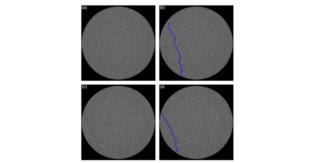| High-speed photography of gas release from bioactive glass by Michiel Postema, Craig S. Carlson, Nicole Anderton, Hu Xinyue, Momoka Yamasaku, Laeticia Petit, Jonathan Massera and Nobuki Kudo in the 63rd volume of the Japanese Journal of Applied Physics in 2024.
Bioactive glass has been of interest for applications in bone regeneration. Floating bioactive glass particles were observed to sink in ultrasound. The purpose of this study was to qualify and quantify bubble formation from floating bioactive glass particles. Water droplets containing borosilicate glass 13-93B20 particles, where 20% of the SiO2 was replaced with B2O3, of dimensions <38 μm were subjected to pulsed ultrasound, whilst being video-recorded at high speed. Measured radial expansions >20 μm corresponded to cavitation nuclei of initial radius 0.6 μm. This study provides experimental evidence that gas trapped inside bioactive glass may be released using high-amplitude ultrasound pulses.
 Microscopic fractures shown inside tablets after impact by Craig S. Carlson, Michiel Postema, Nicole Anderton, Markus Hannula, Joona Sorjonen, Hu Xinyue, Naoyuki Otake, Nobuki Kudo, Jari Hyttinen and Jarkko Ketolainen in the 63rd volume of the Japanese Journal of Applied Physics in 2024. In prior work, rough handling of oral tablets had been observed to drastically speed up their disintegration in water. The purpose of this study was to confirm or refute that the formation of internal microscopic fractures during rough handling is the underlying mechanism. Impacted and control tablets were subjected to micro-computed tomography and to brightness-mode ultrasound. The former revealed fracturing with a maximum crack width of 14 μm. The latter revealed strong acoustic response from the internal structure of the impacted tablets. These results confirm the hypothesis. Disintegration speed is used as a quality control mechanism after tablet manufacturing and transportation.  Dosimetric effect of rotational setup errors in volumetric modulated arc therapy and field-in-field treatment of left-sided breast cancer by Annele Heikkilä, Eeva Boman, Maija Rossi, Antti Vanhanen, Mikko Mankinen, Michiel Postema and Tuomas Koivumäki in the 117th volume of Physica Medica in 2024. Setup errors are an important factor in the dosimetric accuracy of radiotherapy delivery. In this study, we investigated how rotational setup errors influence the dose distribution in volumetric modulated arc therapy (VMAT) and tangential field-in-field (FiF) treatment of left-sided breast cancer with superclavicular lymph node involvement in deep inspiration breath hold. Treatment planning computed tomography images and radiotherapy plans of 20 patients were collected retrospectively for the study. Rotational setup errors up to 3° were simulated by rotating the planning images, and the resulting dosimetric changes were calculated. With rotational setup errors up to 3°, the median decrease of V95% to clinical target volume was less than 0.8 percentage point in both VMAT and FiF plans. The dose distribution of the heart and left anterior descending artery was more stable with respect to rotations in VMAT plans compared to FiF plans. Correction of ≥1° setup errors is recommended due to increased doses to the heart and left anterior descending artery after 1° setup errors.
|
List of publications |
|
The full list of publications can be found on HAL. |
